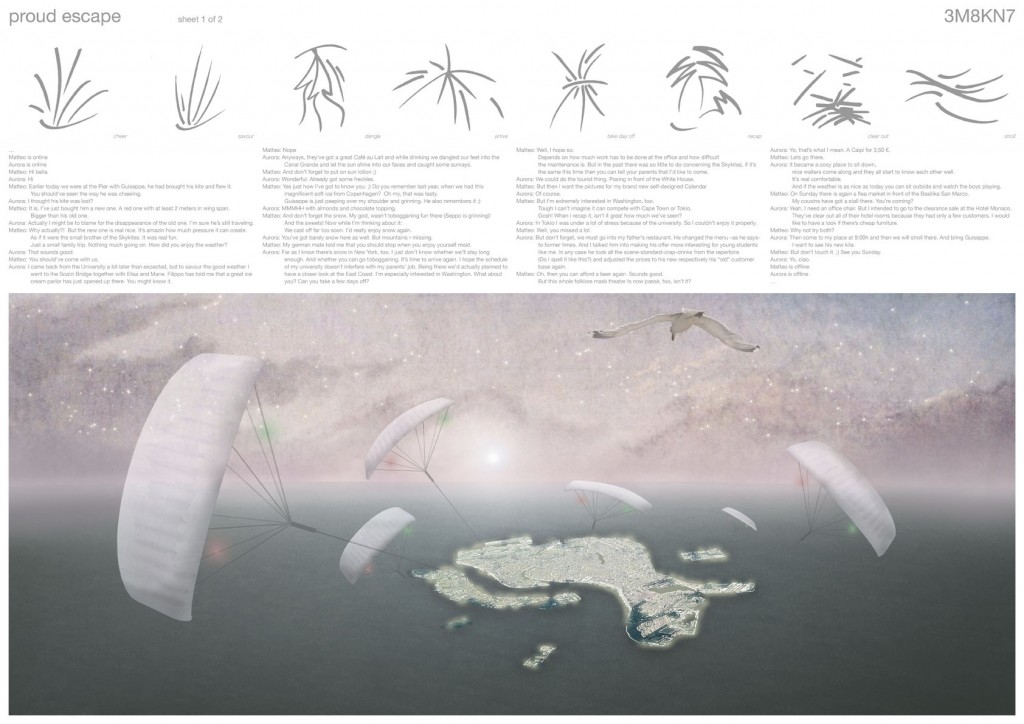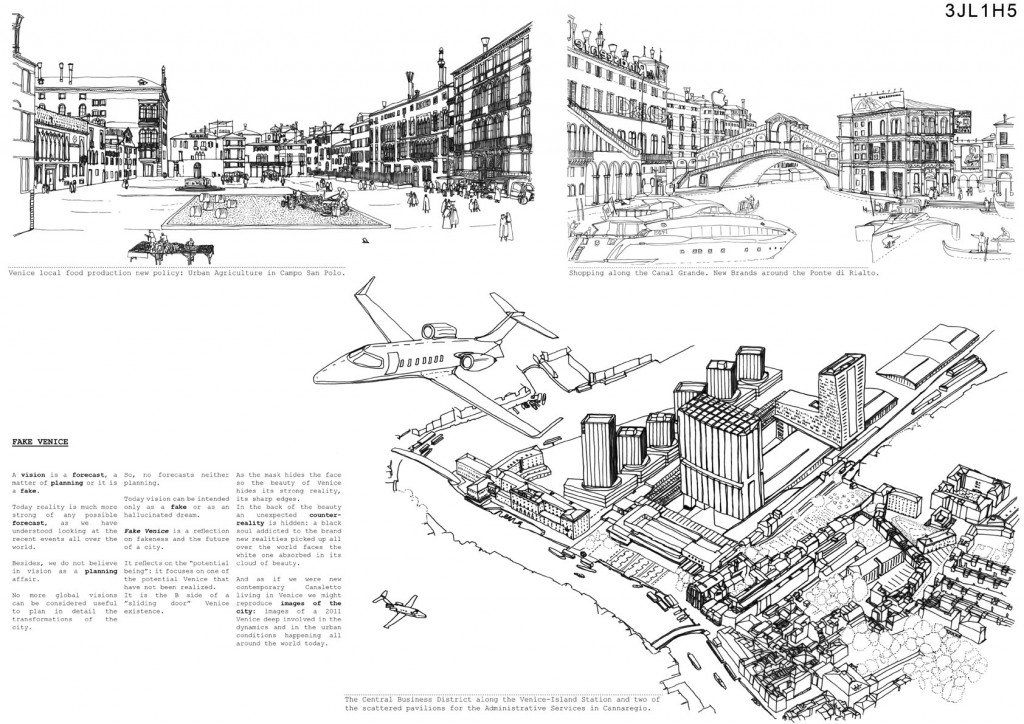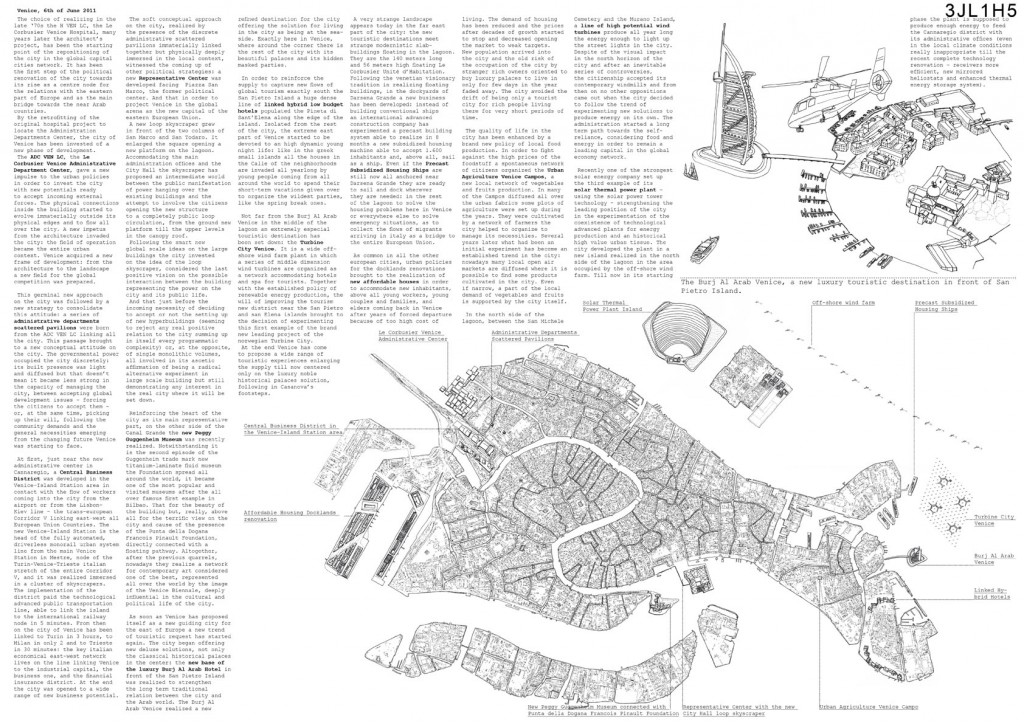Info:
Title: Fake Venice - Code: 3JL1H5Contest: Venice / 2011
By: A. De Matteis
Views: 2992 Likes: 0
Votes:
BJARKE INGELS7 NERI OXMAN5 ELENA MANFERDINI6 MARIA LUDOVICA TRAMONTIN5 BOSTJAN VUGA45.4
Fake Venice
FAKE VENICE A vision is a forecast, a matter of planning or it is a fake. Today reality is much more strong of any possible forecast, as we have understood looking at the recent events all over the world. Starting from the 9/11 till the new internet guided revolutions in the north african arab countries and the strong earthquake happened in Japan that leaded to the tremendous tsunami and the nuclear accident, all of us have seen events all over the world we hardly believe in if they were set up in hollywood movies.
Intending visions on the city as a way to forecast urban conditions the city itself can embody in its real development, we think it is a not relevant procedure: reality in itself will overcome every vision.
Besides, we do not believe in vision as a planning affair. Planning in its main meaning is considered to focus on a imagined global vision that can be imposed at a certain time on the real city to guide its development to get some new conditions decided that are the best: today this attitude showed its less efficacy in driving the urban changes.
This planning attitude, according to which you can impose some general ideas on reality in order to guide it, demonstrates a dirigiste attitude that is not acceptable anymore: we think no ideology can impose its vision forcing the realization of its ideas on the spontaneous systems evolving together in the contemporary urban landscape.
Today no political pluralistic attitude can accept the idea of driving all the transformations of a city to recreate a predefined condition trying to face in that way the ever changing urban conditions that answer to global multilayer relations, from business to the informal network of immigration flows.
The contemporary city as an urban field accepts many and many interacting forces in continuous spontaneous flourishing and decomposing. The only way to work on it is to loose themselves in the sea of the acting forces; and from the inside try to insert local perturbations to the temporary equilibriums: only local reactions to the forces in action in a specific moment on the city can be provided.
No more global visions can be considered useful to plan in detail the transformations of the city.
Global visions on the city could work only as main references: images can represent the city relating it to not-actual conditions forcing reactions in order to produce new ideas of its future, different or not from the directions of development the city seems following.
No forecasts neither planning.
Today vision can be intended only as fake or as an hallucinated dream.
Fakeness is today an highly diffused procedure to re-invent things, re-creating them better then before in new phantom images.
And this is a trend on web, where a huge amount of pictures create false images representing famous celebrities with body changed in best, sometimes exaggerated, or representing them in situations never occurred, often situations far away their real life style.
The aim is to change the actual condition and the destiny of the people represented. The idea is to double their lives in a parallel destiny never occurred but plausible. It is the “sliding doors” syndrome: a life is represented while another one of the possible lives might have occurred.
Indeed, fakeness is to produce a parallel reality stronger than the existing one.
And obviously on the web the huge amount of the fake images are oriented on sexual exposition: fake images represent naked celebrities with hypertrophied organs or involving them in sexual relationships never occurred.
The fakeness involves the much more deep private dimensions: the fake is the tool that can imagine new realities opposite to the real one leveraging on the inner structural condition of life.
And that is Fake Venice: a place in which some conditions never realized before are forced to develop in the city. The bodies of the city become hypertrophied.
The Fake Venice represents a plausible development of the city: one future in the range of its potential developments. The Fake Venice decided to fall in love with certain realities and certain dynamics of the contemporary world that the existing city has always refused to meet and really never met.
Fakeness is a sort of dream.
A dream that is a way in which our sub-conscious during the most intense and deep phase of sleeping guides our mind to elaborate new relations and connections between experiences occurred and not, between reality and fantasy.
Mixed informations define new stories and new realities: useful or not, reproducible or not, used or not as a direction for the real life.
They remain only a fake, an altered reality but for a while they could appear as a spot of an incoming far away future.
Fake Venice is a reflection on fakeness and the future of a city. It reflects on the “potential being”: it focuses on one of the potential Venice that have not been realized.
It is the B side of a “sliding door” Venice existence.
And as the mask hides the face so the beauty of Venice hides its strong reality, its sharp edges. In the back of the beauty an unexpected counter-reality is hidden: a black soul addicted to the brand new realities picked up all over the world faces the white one absorbed in its cloud of beauty.
As if we were new contemporary Canaletto living in Venice we might reproduce images of the city: images of a 2011 Venice deep involved in the dynamics and in the urban conditions happening all around the world today.
Someone could find this Venice more attractive and someone else horrible but it doesn’t matter how you feel it or if you can accept it: the main goal of this Fake Venice is to force the city to be in contact with the contemporary urban forces that drive the world today and to produce public reactions on that trying to answer to certain key questions.
Is it better what Venice is now or what Venice could have been if it would have interacted in its recent past with the contemporary urban conditions not refusing them?
Is it better what Venice is now or what it could have become opening to the main dynamics of the global economy trying to be a node in the network of the global relations as it was during the XIII sec?
Is it better what Venice is now or what Venice could have become accepting to keep in touch with the global contemporary economic tendencies driving their impetus on the city in order to obtain from the global capital investments adequate counterparts for the organization of the city itself?
Probably no answer is possible. The only thing is to restart moving making a quick jump into the reality, whatever it is. It will be possible to make mistakes but the city will be living again, in the real world.
Info:
Title: Fake Venice
Time: 7 giugno 2011
Category: Venice
Views: 2992 Likes: 0
Tags: Adriatic Sea , Future , Japan , New York City , Scripps Institution of Oceanography , Social Sciences , Urban and Regional Planning , Venice








